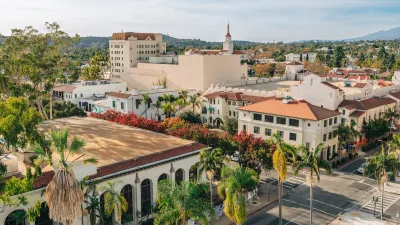Anna Louise Bardach tells the story of Montecito, California, an extremely wealthy enclave near Santa Barbara, which has enough money to buy its way out of the drought.

"Though gifted with green hills and splendid ocean views," writes Bardach, "Montecito has the geologic misfortune to have been built on land with precious little water—indeed, less water than any other part of the central coast of California. An aquifer runs nine miles under southern Santa Barbara County, but only a tiny sliver extends into Montecito."
Since the beginning of the year, the Montecito Water District has implemented restrictions like ceasing construction on new homes, prohibiting the construction of pools and spas, and existing pools and spas being exempt from town water.
"For the most part, residents have embraced the restrictions," explains Bardach, "allowing Montecito to cut its water usage by 48 percent and leaving vast aprons of yellowed lawns as evidence."
The catch, however, is the scofflaws. In May, for instance, "837 defiant—or careless—residents coughed up $532,000 in penalties, or a collective overage of about 13 million gallons of town water."
Then there are cases like Pat Nesbitt, CEO of Windsor Capital (the majority owner of Embassy Suites). Nesbitt has "long sought to convince local officials that his polo field, which is part of his 20 acre estate, is entitled to a discounted agricultural water rate. And he’s sued the Montecito Water District—twice, according to the water district’s attorney—to make his case." (He failed.)
Others are simply paying to ship water in from other, also presumably drought stricken locations. The most famous example, according to the anecdote that opens the article, is Oprah's 40-acre estate.
FULL STORY: Lifestyles of the Rich and Parched

Alabama: Trump Terminates Settlements for Black Communities Harmed By Raw Sewage
Trump deemed the landmark civil rights agreement “illegal DEI and environmental justice policy.”

Study: Maui’s Plan to Convert Vacation Rentals to Long-Term Housing Could Cause Nearly $1 Billion Economic Loss
The plan would reduce visitor accommodation by 25% resulting in 1,900 jobs lost.

Why Should We Subsidize Public Transportation?
Many public transit agencies face financial stress due to rising costs, declining fare revenue, and declining subsidies. Transit advocates must provide a strong business case for increasing public transit funding.

Paris Bike Boom Leads to Steep Drop in Air Pollution
The French city’s air quality has improved dramatically in the past 20 years, coinciding with a growth in cycling.

Why Housing Costs More to Build in California Than in Texas
Hard costs like labor and materials combined with ‘soft’ costs such as permitting make building in the San Francisco Bay Area almost three times as costly as in Texas cities.

San Diego County Sees a Rise in Urban Coyotes
San Diego County experiences a rise in urban coyotes, as sightings become prevalent throughout its urban neighbourhoods and surrounding areas.
Urban Design for Planners 1: Software Tools
This six-course series explores essential urban design concepts using open source software and equips planners with the tools they need to participate fully in the urban design process.
Planning for Universal Design
Learn the tools for implementing Universal Design in planning regulations.
Smith Gee Studio
Alamo Area Metropolitan Planning Organization
City of Santa Clarita
Institute for Housing and Urban Development Studies (IHS)
City of Grandview
Harvard GSD Executive Education
Toledo-Lucas County Plan Commissions
Salt Lake City
NYU Wagner Graduate School of Public Service



























